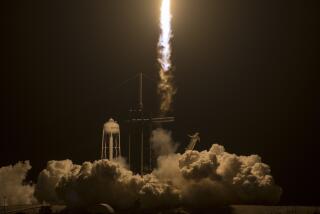NASA Now Aiming for a Launch on Tuesday
- Share via
NASA officials believe they have uncovered the problem behind a faulty fuel sensor on the shuttle Discovery and will count down to a Tuesday launch.
After about a week of troubleshooting the problem that scrubbed a July 13 launch, officials said they had narrowed the cause of the failure to a possible electrical grounding problem in a complex piece of electronic equipment called the point sensor box.
They also said they were considering the possibility that changes to the external fuel tank made after the 2003 Columbia disaster could have caused the electrical problem, a possibility NASA had dismissed earlier.
“This has been a very, very thorough effort,” Shuttle Program Manager Bill Parsons said at a news conference Wednesday at Kennedy Space Center in Florida.
Parsons said troubleshooting would continue.
The countdown will resume Saturday for a launch at 7:39 a.m. PDT Tuesday.
The seven-member Discovery crew was within 2 1/2 hours of launch last week when one of four fuel sensors responded incorrectly to commands.
Since then, a dozen engineering teams across the country have been analyzing the shuttle’s cables, wiring and sensors. They began zeroing in this week on the point sensor box, where electronics cards pass signals from fuel tank sensors and to the shuttle’s computer.
The troubleshooters also are suspicious of a heater added after the Columbia accident to prevent ice formation on the external fuel tank.
In one test, the sensor failed only seconds after the heater was turned on.
To test current theories, workers will swap positions of the problem sensor with one that has consistently worked. They also are reworking some grounding areas.
Managers also said for the first time that they may be willing to launch the shuttle with only three of the four sensors operating correctly.
The sensors are designed to cut off the main engines before they run out of fuel and potentially cause a catastrophic engine failure.
If they cut off the engines too soon, however, the shuttle might not reach orbit.
In the early days of the shuttle program, three working sensors were considered safe enough for launch.
That changed after the 1986 Challenger accident.
Shuttle engineering chief John Muratore said his teams had analyzed 350 items to find the electrical glitch in Discovery.
They have simulated filling the fuel tank 10 times, trying to re-create the conditions under which the sensor failed.
The tests were conducted with the tank empty. Under launch conditions, it is filled with liquid oxygen and liquid hydrogen fuel, cooled to minus 423 degrees Fahrenheit.
NASA engineers have opted against doing a full test with the tanks filled. Instead, they will simply reinitiate the countdown, fill the tank and test the sensors then.
Officials said they may proceed with a launch even if they encounter another failure, as long as they are confident that the problem is minor.
Another unexplained problem during the countdown would scrub the launch again, pushing it into September.
More to Read
Sign up for Essential California
The most important California stories and recommendations in your inbox every morning.
You may occasionally receive promotional content from the Los Angeles Times.













